Discover 35 hidden attractions, cool sights, and unusual things to do in Little Rock (United States). Don't miss out on these must-see attractions: Clinton Presidential Center, Simmons Bank Arena, and Arkansas State Capitol. Also, be sure to include Old State House in your itinerary.
Below, you can find the list of the most amazing places you should visit in Little Rock (Arkansas).
Table of Contents
Clinton Presidential Center
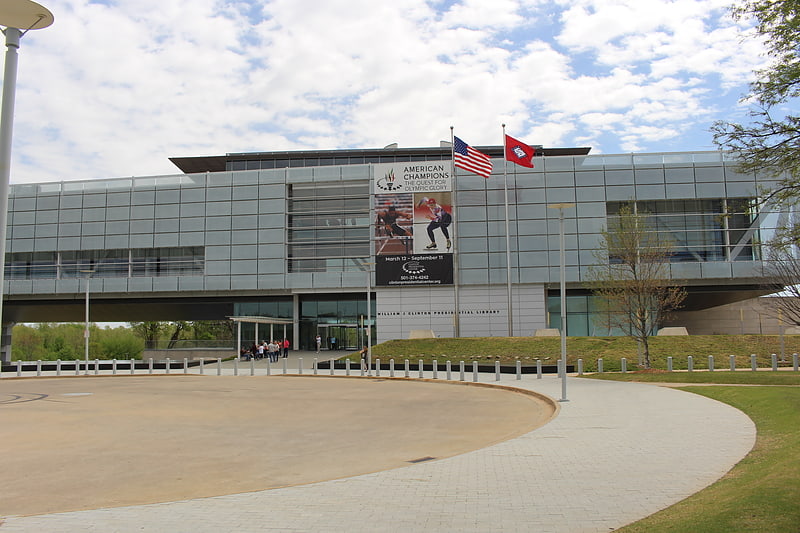
Exhibits on the 42nd President . The William J. Clinton Presidential Library and Museum is the presidential library of Bill Clinton, the 42nd president of the United States. It is located in Little Rock, Arkansas and includes the Clinton Presidential Library, the offices of the Clinton Foundation, and the University of Arkansas Clinton School of Public Service. It is the thirteenth presidential library to have been completed in the United States, the eleventh to be operated by the National Archives and Records Administration, and the third to comply with the Presidential Records Act of 1978.
It is situated on 17 acres (69,000 m2) of land located next to the Arkansas River and Interstate 30 and was designed by architectural firm Polshek Partnership, LLP with exhibition design by Ralph Appelbaum Associates. Polk Stanley Wilcox Architects also contributed. The main building cantilevers over the Arkansas River, echoing Clinton's campaign promise of "building a bridge to the 21st century". With a 68,698-square-foot (6,382.3 m2) floor plan, the library itself is the largest presidential library in terms of physical area, although the Ronald Reagan Presidential Library has the greatest space overall, due to its addition of the 90,000 square feet (8,400 m2) Air Force One Pavilion in 2005. The archives are the largest as well, containing 2 million photographs, 80 million pages of documents, 21 million e-mail messages, and 79,000 artifacts from the Clinton presidency. The Clinton Library is also the most expensive, with all funding coming from 112,000 private donations.
The museum showcases artifacts from Clinton's two terms as president and includes full-scale replicas of the Clinton-era Oval Office and Cabinet Room.[1]
Address: River Market District, Little Rock
Simmons Bank Arena

Arena in North Little Rock, Arkansas. Simmons Bank Arena is an 18,000-seat multi-purpose arena in North Little Rock, Arkansas, directly across the Arkansas River from downtown Little Rock. Opened in October 1999, it is the main entertainment venue serving the greater Little Rock area.
The Arkansas–Little Rock Trojans, now known for sports purposes as the Little Rock Trojans and representing the University of Arkansas at Little Rock in NCAA Division I sports, played home basketball games at the arena from the time when the arena opened until the team moved in 2005 to a new arena, the Jack Stephens Center, on the school's campus in Little Rock. The Arkansas RiverBlades, a defunct ice hockey team of the ECHL, the Arkansas RimRockers, a defunct minor league basketball team of the NBA Development League, and the Arkansas Twisters, a defunct af2 team, also played at the arena. The arena is also used for other events, including concerts, rodeos, auto racing, professional wrestling, and trade shows and conventions.[2]
Address: 1 Verizon Arena Way, 72114-5681 Little Rock
Arkansas State Capitol

Government office in Little Rock, Arkansas. The Arkansas State Capitol, often called the Capitol Building, is the home of the Arkansas General Assembly, and the seat of the Arkansas state government that sits atop Capitol Hill at the eastern end of the Capitol Mall in Little Rock, Arkansas.[3]
Address: Little Rock, 500 Woodlane Street
Old State House
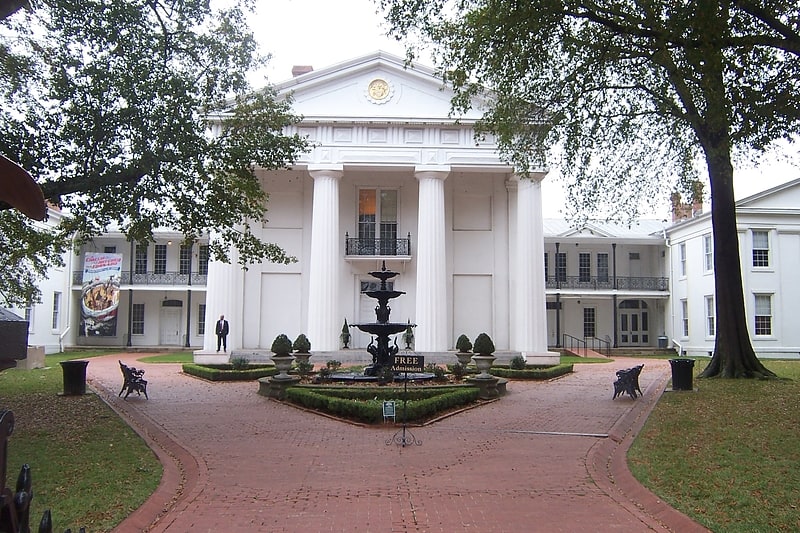
Museum in Little Rock, Arkansas. The Old State House, formerly called the Arkansas State House, is the oldest surviving state capitol building west of the Mississippi River. It was the site of the secession convention, as well as the fourth constitutional convention when delegates agreed to ensure voting rights for freedmen and establish public education.[4]
Address: Little Rock, 300 W. Markham St.
Ten Commandments Monument
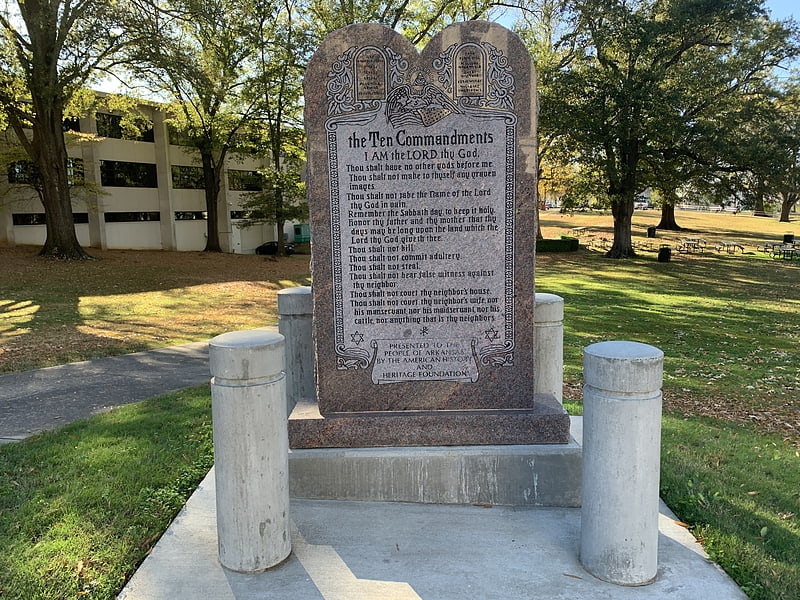
The Ten Commandments Monument is an outdoor monument installed on the Arkansas State Capitol grounds in Little Rock, Arkansas, in the United States. The monument is being challenged as unconstitutional by the American Civil Liberties Union. The ACLU says that the monument demonstrates a religious preference, violating the First Amendment and the religious preference prohibition clause of the Arkansas State Constitution.[5]
Big Dam Bridge

Pedestrian bridge in North Little Rock, Arkansas. Originally intended to be called Murray Bridge, the Big Dam Bridge in Arkansas spans the Arkansas River and Murray Lock and Dam between Little Rock and North Little Rock and is open only to pedestrian and bicycle traffic. At 4,226 feet in length it is the longest pedestrian/bicycle bridge in North America that has never been used by trains or motor vehicles. It rises to 90 feet over the Arkansas River and 30 feet over the dam. The span over the river is 3,463 feet, with the ramps on either side of the river accounting for the rest of the length. The southern end of the bridge is near Little Rock's Murray Park, while the northern end is at Cook's Landing Park in North Little Rock.
The nickname was given by Pulaski County Judge F.G. “Buddy” Villines, who was concerned about the financing needed and was quoted to say, "We're going to build that dam bridge." (He insisted he was referring to its location on a dam, and was not using the mild expletive.) The construction cost was $12.8 million.
The opening ceremony was held on Saturday, September 30, 2006. Local politicians boasted that the bridge will boost the local economy and contribute to the health of the population. The bridge and adjacent parks are used for several races including the Big Dam Bridge 100 cycling tour, the BDB Twilight 5k race, and the BDB Duathlon.
The Federal Highway Administration gave one of its first Exemplary Human Environment Initiative awards to the bridge, and Illuminating Engineer Society gave its Award of Merit at the international level to the bridge's LED lighting design.[6]
Historic Arkansas Museum

Museum in Little Rock, Arkansas. The Historic Arkansas Museum, sometimes called HAM, is a state history museum in downtown Little Rock, Arkansas.
The museum was created as part of the Arkansas Territorial Capitol Restoration Commission, by Act 388 of the 1939 Arkansas General Assembly. The act named Louise Loughborough as chairwoman of the commission. Loughborough had been named to the Little Rock Planning Commission in 1935. Several houses near Cumberland and East 3rd Streets in downtown Little Rock were going to be condemned, including the Hinderliter House, the oldest building in Little Rock. Loughborough started a public relations campaign around Little Rock as a "town of three Capitols": the Hinderliter House, the Old State House, and the current Arkansas State Capitol Building. Use of the Hinderliter House as the last meeting place of the Arkansas Territorial Legislature has remained part of popular folklore, though it is not known if it was used for this purpose. Loughborough then gained support from the Works Progress Administration, the Arkansas General Assembly, and private donors. Loughborough worked with architect Max Mayer to restore the half-block of houses at Cumberland and East 3rd Street in downtown Little Rock. The Museum opened on July 19, 1941.
The museum maintains gallery space and a number of historic buildings original to the site, as well as log structures transported from around the state. It was previously known as the Arkansas Territorial Restoration, but the name was changed in 2001 when new exhibit space and renovations were completed. The museum is an affiliate within the Smithsonian Affiliations program. The museum property was listed on the National Register of Historic Places in 2019 as the Arkansas Territorial Restoration Historic District.[7]
Address: 200 E 3rd St, 72201-1608 Little Rock
Arkansas Inland Maritime Museum

Museum in Pulaski County, Arkansas. The Arkansas Inland Maritime Museum is a maritime museum located at 120 Riverfront Park Drive, North Little Rock, Arkansas which opened on May 15, 2005. The museum includes artifacts from the nuclear-powered cruiser USS Arkansas, including the ship's bell and anchor, which are on public display.
The museum's primary exhibit is USS Razorback, a Balao-class submarine, which served during World War II (commissioned in 1944) and then served in the Korean, Vietnam and Cold Wars. The submarine was eventually transferred to the Turkish Navy (serving as TCG Muratreis until 2001) before returning to the US to become a museum ship. It is arguably the longest-serving submarine still existing in the world, and was commissioned by the United States and Turkey for 57 years of active duty (Taiwan has two World War II-era submarines that have been continuously in service since 1945 and 1946 first with the US Navy and then the Republic of China Navy, which are ROCS Hai Shih and ROCS Hai Pao). The museum provides tours of Razorback and even offers sleepovers on the submarine.
Hoga, a US Navy tugboat, which survived and responded to the Attack on Pearl Harbor, was acquired by the museum on 28 November 2015.
The museum has vessels that are bookends for the US in World War II, with Hoga from the beginning of the war at Pearl Harbor, alongside Razorback which was present in Tokyo Bay at the surrender of Japan.[8]
Address: 120 Riverfront Park Dr, 72114-5640 North Little Rock
Museum of Discovery

Museum in Little Rock, Arkansas. The Museum of Discovery is located in downtown Little Rock, Arkansas. The museum is housed in a historic building in the River Market District on the Arkansas River. The Clinton Presidential Center is within walking distance.[9]
Address: 500 President Clinton Ave, 72201-1756 Little Rock
Monument to Confederate Women
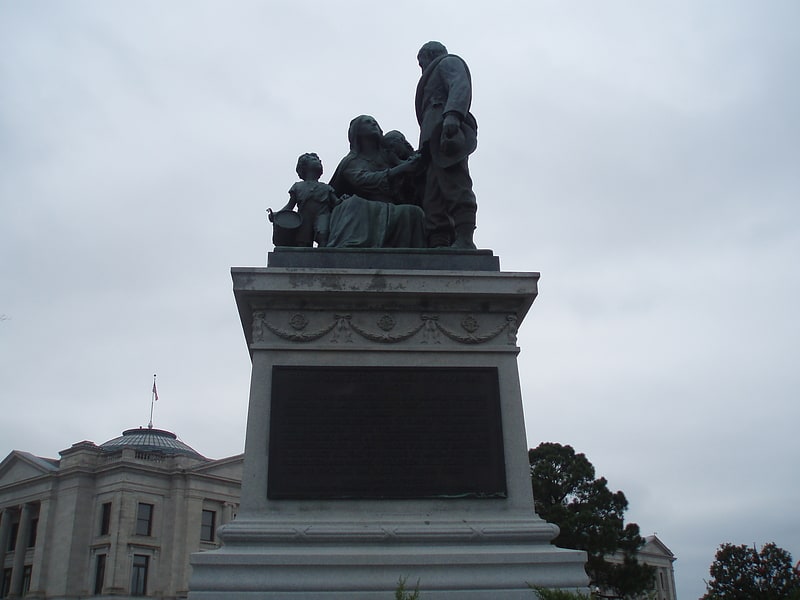
Monument in Little Rock, Arkansas. The Monument to Confederate Women, also known as the "Mother of the South", is a commemorative sculpture on the grounds of the Arkansas State Capitol in Little Rock, Arkansas. It depicts a mother and two of her children saying goodbye to an older son who is dressed in a Confederate uniform. The sculpture is cast in bronze, and stands over 7 feet in height. It is mounted in a multi-tiered pedestal, nearly 12 feet in height, with sections made of concrete, granite, and marble. The statue was created by J. Otto Schweizer, and was dedicated in 1913. It was funded by the United Confederate Veterans.
The memorial was listed on the National Register of Historic Places in 1996.[10]
Mount Holly Cemetery
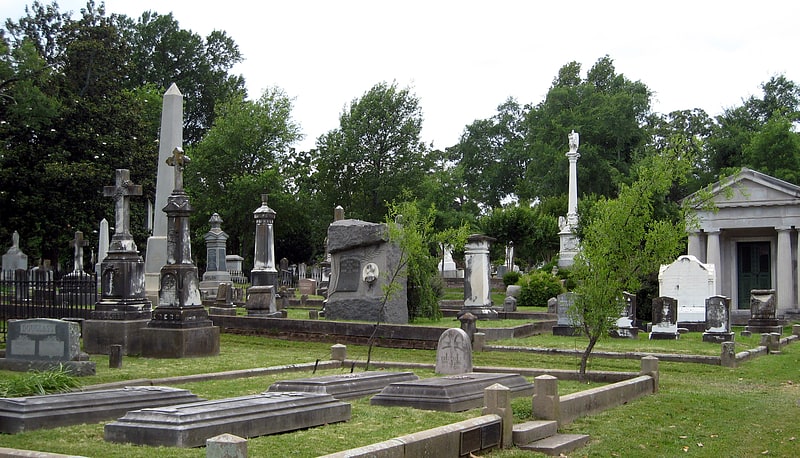
Cemetery in Little Rock, Arkansas. Mount Holly Cemetery is a historic cemetery located in the Quapaw Quarter area of downtown Little Rock in the U.S. state of Arkansas, and is the burial place for numerous Arkansans of note. It was listed on the National Register of Historic Places in 1970 and has been nicknamed "The Westminster Abbey of Arkansas".[11]
Address: 1200 Broadway St, 72202-4831 Little Rock
Tower Building of the Little Rock Arsenal
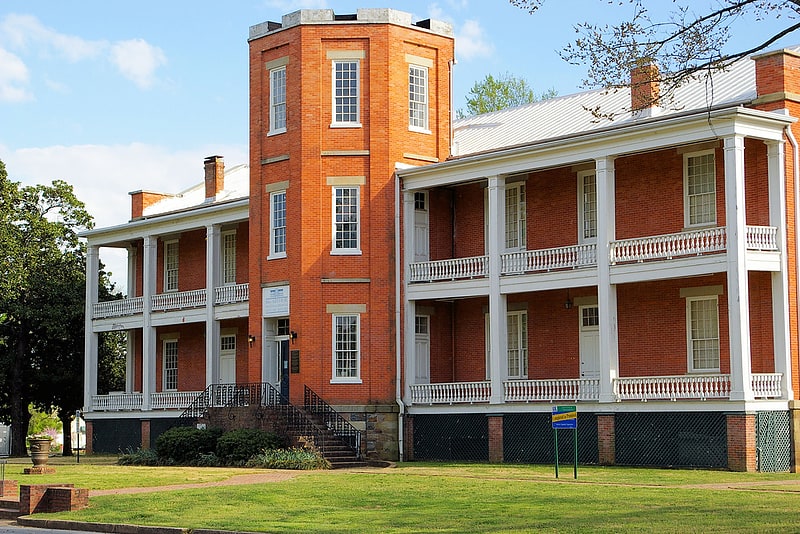
Building. The Tower Building of the Little Rock Arsenal, also known as the Main Building of the U.S. Arsenal at Little Rock, or Headquarters Building of the Little Rock Barracks, is the home of the MacArthur Museum of Arkansas Military History. It is also a part of the MacArthur Park Historic District, in Little Rock, Arkansas.
Built between 1840 and 1841, it was part of Little Rock's first U.S. military installation. Since decommissioning, the building has housed two local museums. It was home to the Arkansas Museum of Natural History and Antiquities from 1942 to 1997 and the MacArthur Museum of Arkansas Military History since 2001. It has also housed the Little Rock Æsthetic Club since 1894. The building receives its name from its distinct octagonal tower. Besides being the last remaining structure of the original U.S. military installation and one of the oldest buildings in central Arkansas, it was also the birthplace of General Douglas MacArthur, who became the supreme commander of U.S. forces in the South Pacific during World War II. It was also the starting place of the Camden Expedition during the American Civil War.[12]
Little Rock National Cemetery
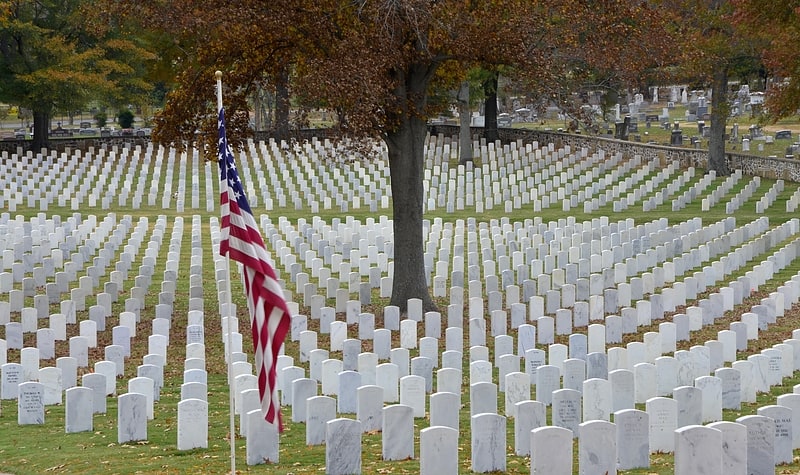
Cemetery. Little Rock National Cemetery is a United States National Cemetery, located two miles south of the city of Little Rock, in Pulaski County, Arkansas. It encompasses 31.7 acres, and as of the end of 2005, had 25,172 interments. Administered by the United States Department of Veterans Affairs, it is currently closed to new interments.[13]
Address: 2523 Springer Blvd, Little Rock
Confederate Soldiers Monument
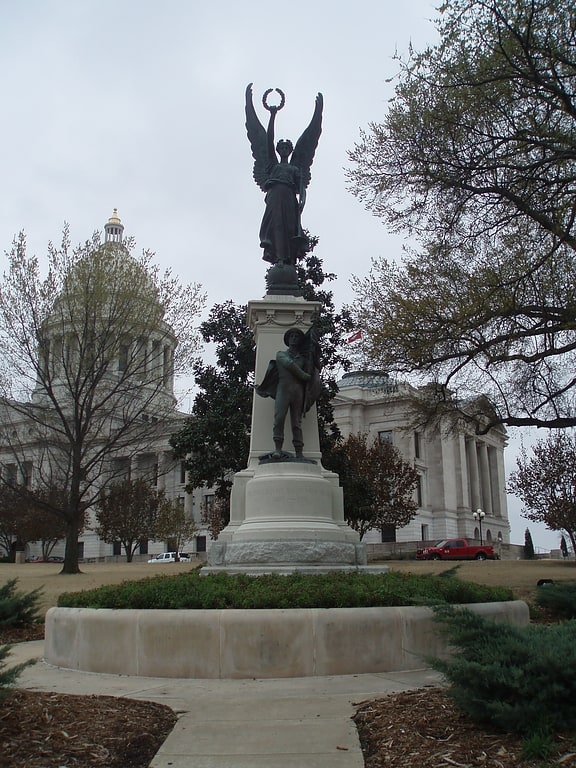
The Arkansas Confederate Soldiers Monument, also known as Defense of the Flag, is located on the east side of the Arkansas State Capitol grounds in Little Rock, just off 4th Street. It is a five-tiered marble structure, topped by a bronze statue of an angel standing on a sphere, and a bronze Confederate Army soldier on the front of its fourth tier. It was built in 1904–05, with funding from a variety of sources, including the state, primarily through the efforts of a consortium of Confederate memorial groups. Originally located prominently near the main eastern entrance to the capitol building, it was later moved to its present location on the northeast lawn.
The monument was listed on the National Register of Historic Places in 1996.[14]
Marshall Square Historic District
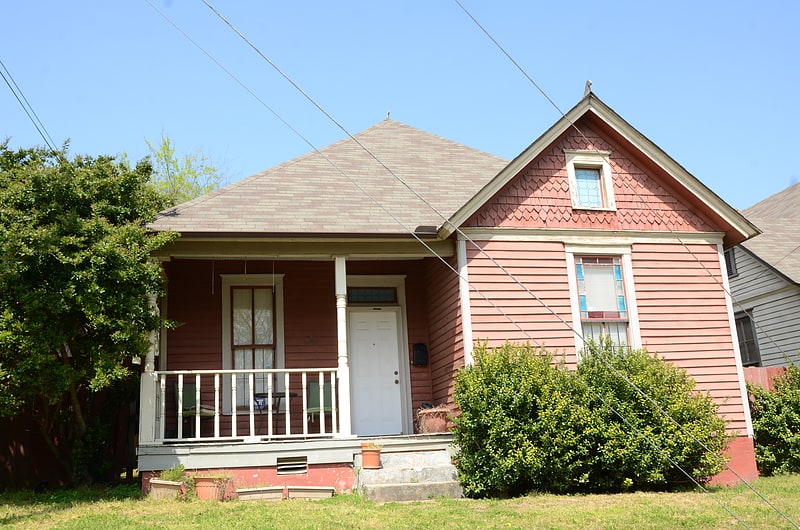
Historical place in Little Rock, Arkansas. The Marshall Square Historic District encompasses a collection of sixteen nearly identical houses in Little Rock, Arkansas. The houses are set on 17th and 18th Streets between McAlmont and Vance Streets, and were built in 1917-18 as rental properties Josephus C. Marshall. All are single-story wood-frame structures, with hip roofs and projecting front gables, and are built to essentially identical floor plans. They exhibit only minor variations, in the placement of porches and dormers, and in the type of fenestration.
The district was listed on the National Register of Historic Places in 1979.[15]
Memorial to Company A

The Memorial to Company A, Capitol Guards was an American Civil War memorial in MacArthur Park, Little Rock, Arkansas. It stood just northeast of the former Tower Building of the Little Rock Arsenal, at a junction of two of the park's internal roadways. It consisted of a bronze sculpture depicting a Confederate Army soldier in a defensive stance, holding a rifle pointed forward. The statue was 8 feet in height, and was mounted in a granite column 16 feet tall. The memorial was sometimes known as "Lest we forget", a line that appeared near the top of the inscription on the base. The statue was created by sculptor Rudolph Schwarz, and was installed in 1911; it was paid for by the local chapter of the Sons of Confederate Veterans, and memorializes the unit that seized the arsenal at the outset of the war.
The memorial was listed on the National Register of Historic Places in 1996, and was delisted in 2021. The statue was removed in June 2020 following the George Floyd protests.[16]
St. Edwards Church
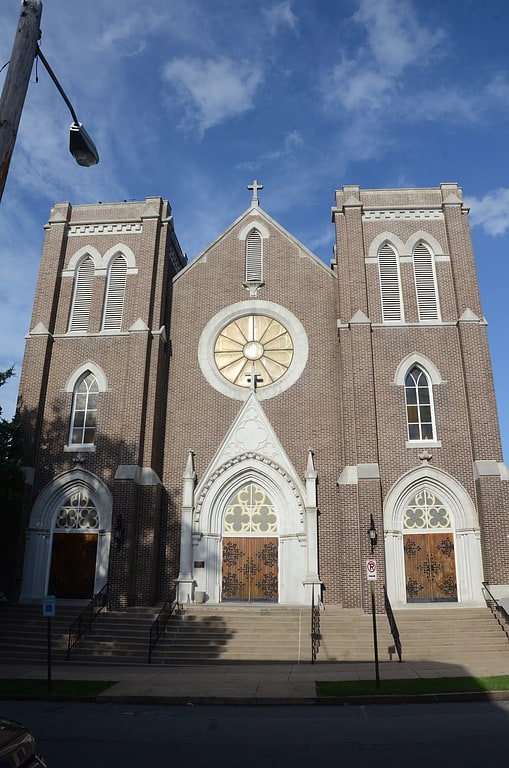
Catholic church in Little Rock, Arkansas. St. Edwards Church is a historic Roman Catholic church at 801 Sherman Street in Little Rock, Arkansas, United States. Built in 1901, it is a handsome Gothic Revival structure, built out of brick with stone trim. A pair of buttressed towers flank a central gabled section, with entrance in each of the three parts set in Gothic-arched openings. A large rose window stands above the center entrance below the gable, where there is a narrow Gothic-arched louver. Designed by Charles L. Thompson, it is the most academically formal example of the Gothic Revival in his portfolio of work.
The building was listed on the National Register of Historic Places in 1982.[17]
Address: 815 Sherman St, Little Rock
David O. Dodd Memorial
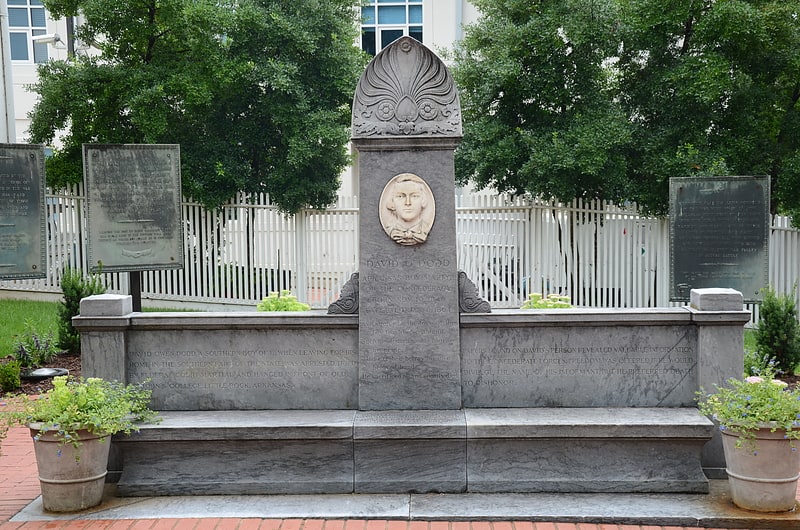
The David O. Dodd Memorial is a monument on the grounds of the Old State House in Little Rock, Arkansas. Erected in 1923 by Confederate memorial groups, it commemorates David O. Dodd, an Arkansas civilian who was executed by the U.S. Army for spying. The monument has a horizontal base of gray marble, with a central columnar component, in which a relief portrait of Dodd is carved into white marble. It was listed on the National Register of Historic Places in 1996.[18]
Oakland-Fraternal Cemetery

Cemetery in Little Rock, Arkansas. The Oakland-Fraternal Cemetery is a historic cemetery on Barber Street in Little Rock, Arkansas. It actually consists of six originally separate cemeteries, and lies adjacent to the Little Rock National Cemetery, of which it was once a part. Portions of the cemetery are dedicated to Confederate war dead, and its grounds include two separate Jewish cemeteries, and the Fraternal Cemetery, a burying ground for African Americans. The cemetery, listed on the National Register of Historic Places in 2010, continues in active use.
Vaudeville performer Thomas Pankey is buried at Fraternal Cemetery as well as Mifflin W. Gibbs. Dr. D. B. Gaines and educator Carrie Shepperson, mother of composer William Grant Still.[19]
Minnesota Monument
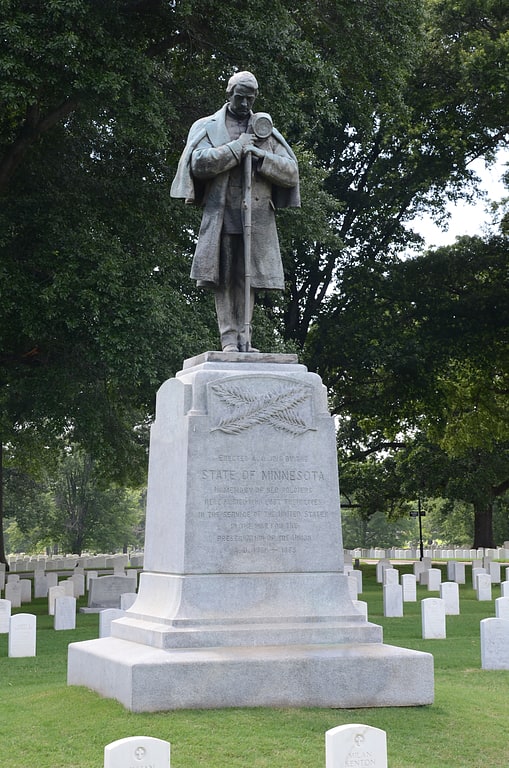
Monument in Little Rock, Arkansas. The Minnesota Monument is an American Civil War memorial in the Little Rock National Cemetery in Little Rock, Arkansas. Also known as "Taps", it depicts a Union Army soldier, his bare head slightly bowed. His hands resting on the butt of his rifle, which is inverted, with the barrel resting on the ground. The bronze sculpture is 7 feet tall, and is mounted on a granite base about 8 feet tall. It is dedicated to the 36 soldiers from Minnesota who are buried here. The sculpture was designed by John Karl Daniels, and was funded by the state of Minnesota. It was dedicated in 1916.
The memorial was listed on the National Register of Historic Places in 1996.[20]
Broadway Bridge

Bridge in Pulaski County, Arkansas. The Broadway Bridge is an arch bridge that spans the Arkansas River connecting the cities of Little Rock, Arkansas and North Little Rock, Arkansas. It carries U.S. Route 70. The current bridge opened to traffic in March 2017. The original bridge was demolished in 2016. It was also an arch bridge and it opened in 1923.[21]
Address: Broadway St, 72114 North Little Rock
ESSE Purse Museum
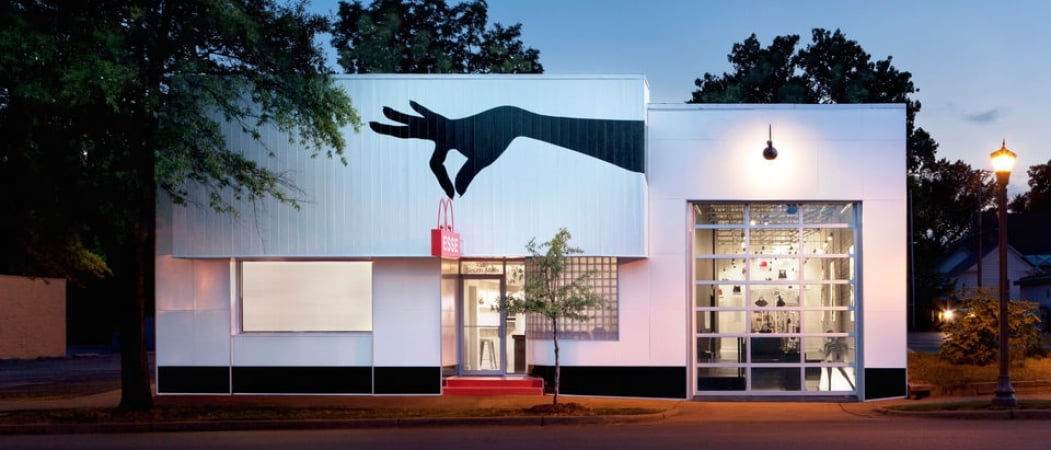
Museum in Little Rock, Arkansas. The ESSE Purse Museum is a museum located in Little Rock, Arkansas featuring women's handbags, and the day-to-day items carried in them, illustrating the stories of American women's lives during the 1900s. Special topic exhibits are hosted, and the museum has a gift shop. The museum's name is derived from the Latin infinitive for "to be".[22]
Address: 1510 Main St, 72202-5038 Little Rock
Daisy Bates House
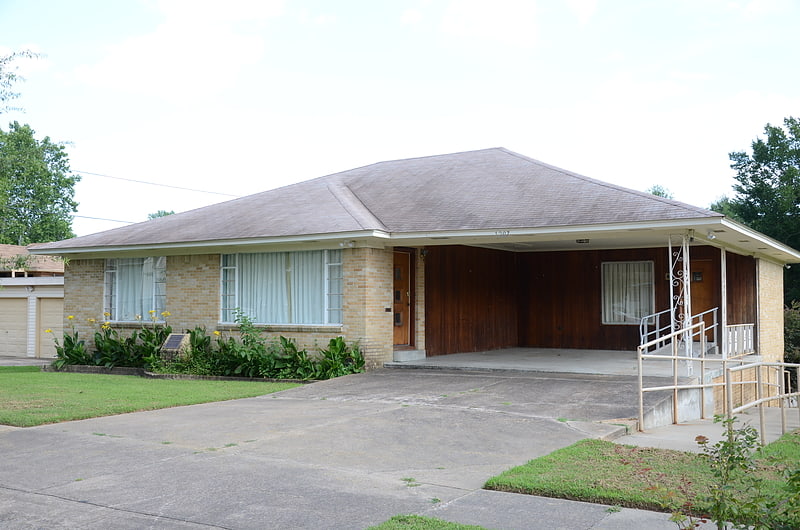
The Daisy Bates House is a historic house at 1207 West 28th Street in Little Rock, Arkansas, USA. It is significant as the home of Arkansas NAACP president Daisy Bates, and for its use as a command post for those working to desegregate the Little Rock Central High School during the desegregation crisis of 1957–1958. It was a sanctuary for the nine students involved. It was declared a National Historic Landmark in 2001.[23]
Address: 1207 W 28th St, Little Rock
Central Arkansas Library System
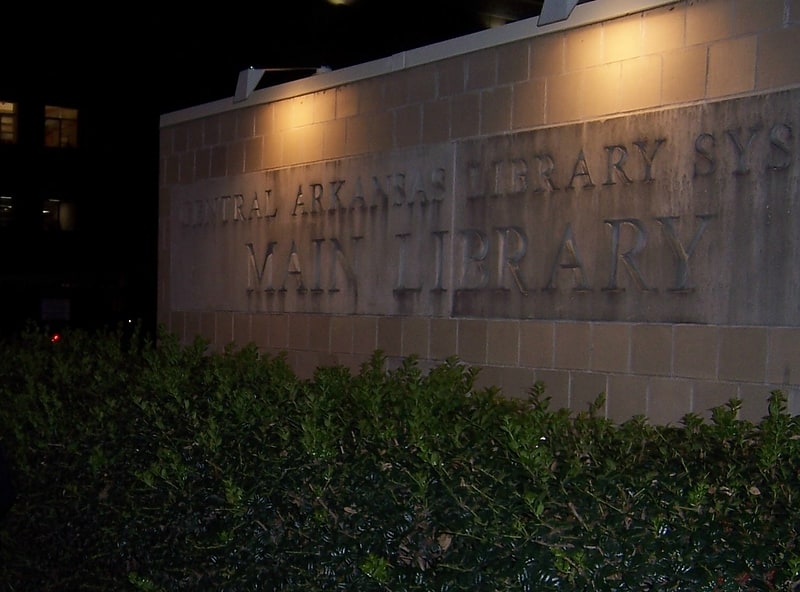
Public library system. Central Arkansas Library System is a public library system headquartered in Little Rock, Arkansas.
The largest public library system in Arkansas, the Central Arkansas Library System serves all residents of Pulaski County and Perry County, including Little Rock, Jacksonville, Maumelle, Perryville, Sherwood, and Wrightsville. So. The main Library in downtown Little Rock is the main branch of the system. The Main Library campus also includes the Arkansas Studies Institute Building, which includes the offices of the Butler Center for Arkansas Studies, the Encyclopedia of Arkansas, and the UALR Center for Arkansas History and Culture. CALS' Ron Robinson Theater, Cox Creative Center, and River Market Books & Gifts are also located on the Main Library campus.[24]
Address: 100 S Rock St, 72201 Little Rock
Block 35 Cobblestone Alley
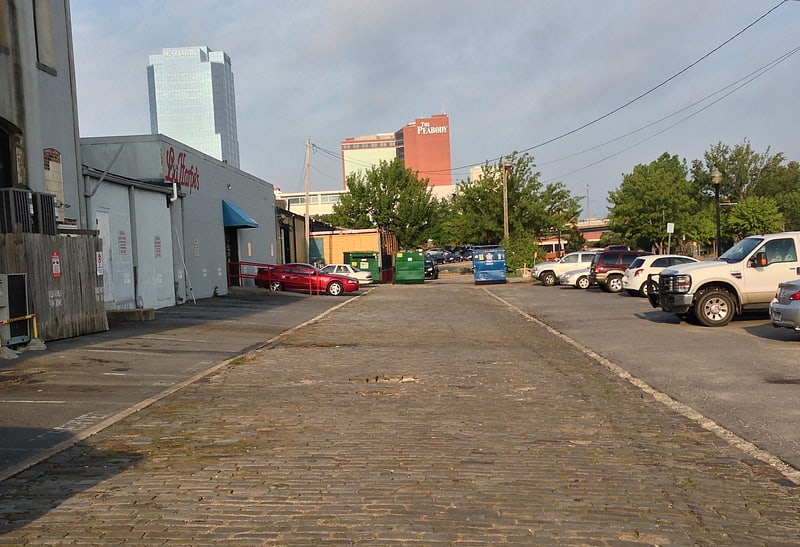
Block 35 Cobblestone Alley is located in Little Rock, Arkansas. It is a 300-foot-long, 30-foot-wide cobblestone alley, which bisects a city block known as Block 35 of the City of Little Rock. It was originally surfaced around 1889, and is one of the city's few surviving brick-paved alleys. It provides access to the rear of buildings facing President Clinton Boulevard. It was listed on the National Register of Historic Places in January, 2009.
It was listed as a featured property of the week in a program of the National Park Service that began in July, 2008.[25]
Arkansas Governor's Mansion
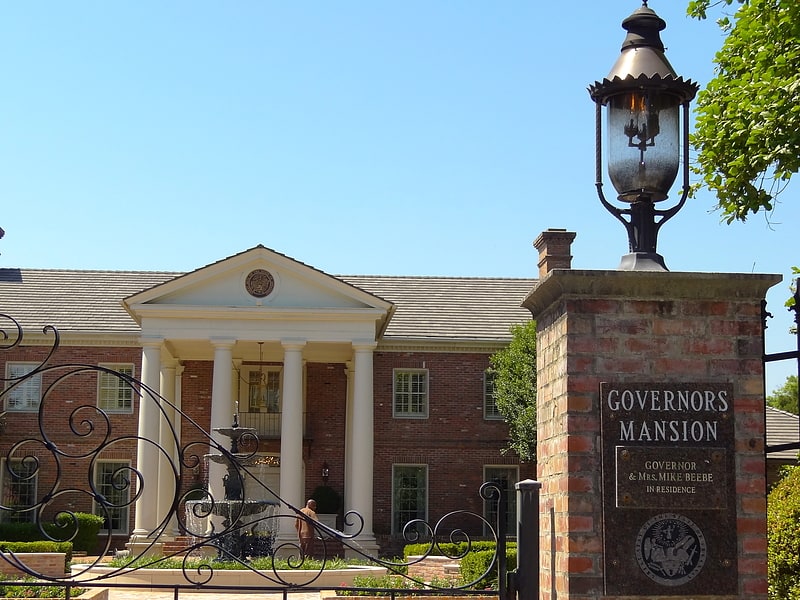
Official residence in Little Rock, Arkansas. The Arkansas Governor's Mansion is the official residence of the governor of Arkansas and Arkansas' first family. The mansion is located at 1800 Center Street in Little Rock, and is included in the Governor's Mansion Historic District, a district that is listed on the National Register of Historic Places.
Until 1950, the State of Arkansas did not have an official residence for its governor.[26]
Address: 1800 Center St, 72206-1418 Little Rock
Arkansas School for the Deaf
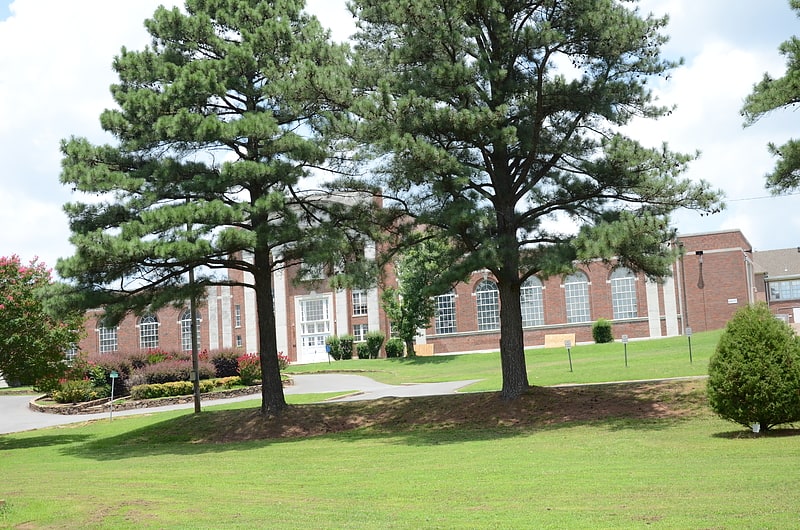
State school in Little Rock, Arkansas. Founded in 1850, the Arkansas School for the Deaf is a state-run public school in Little Rock, Arkansas, United States, serving deaf and hard of hearing students through residential, day school, and part-time enrollment programs. The school offers preschool through high school, and is affiliated with the Arkansas Association of the Deaf and the National Association of the Deaf.
The school is located near the Arkansas School for the Blind (ASB) and both are administered by a five-member panel known as the Board of Trustees ASB-ASD.
The Arkansas Department of Education (ADE) classifies it as a school district.[27]
Address: 2400 West Markham, Little Rock
Argenta Historic District
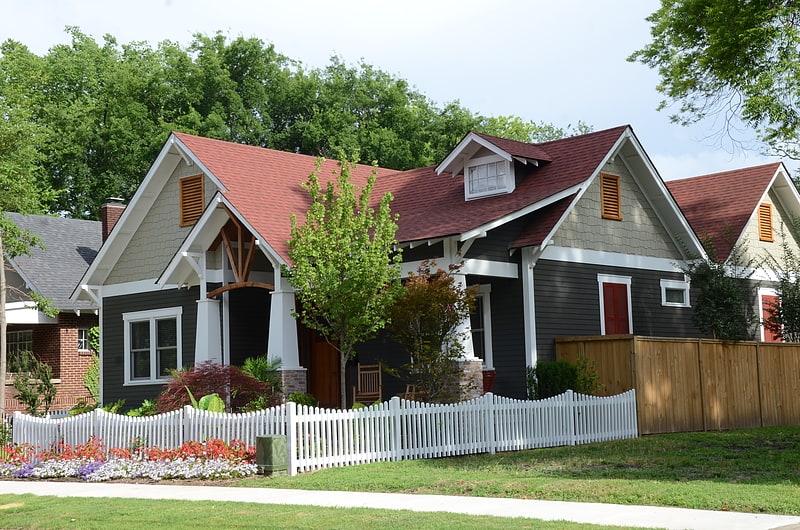
The Argenta Historic District encompasses significant historic elements of central North Little Rock, Arkansas. The area that is now central North Little Rock was known as Argenta when it was first settled, and remained unincorporated until it was annexed to Little Rock in 1890. William Faucette, a leading Argenta politician and businessman, orchestrated the incorporation of North Little Rock just beyond the annexed area in 1901, and then made a successful petition to separate Argenta from Little Rock into the new municipality in 1903. Subsequent attempts to rename North Little Rock to Argenta have failed.
The district consists of two discontinuous areas, one commercial and the other residential. The commercial section consists of a three-block stretch of Main Street, between Broadway Street and 6th Street. Three blocks west of this area is the residential area, which is centered on a stretch of Willow Street from 4th to Melrose Circle, that also includes properties on adjoining blocks of cross streets in between. The district was first listed on the National Register of Historic Places in 1993. In 2002 it was amended to change the status of five buildings to contributing status, as they had undergone appropriate historic restoration work.
The commercial section of the district was primarily developed between 1900 and 1940, and includes 18 historically significant buildings, including six that are separately listed on the National Register: North Little Rock City Hall, the former North Little Rock Post Office (now the Argenta Branch Library), the Faucette Building, and the Old Central Fire Station are among them. The residential section includes 177 buildings in total, of which 77 were initially deemed historically significant, including the separately-listed Baker House and Barth-Hempfling House. Many of the non-contributing properties are of an appropriate age, and were only excluded because of the application of inappropriate exterior siding materials and other reversible or restorable alterations. The majority of residential buildings are Craftsman in style, although there are large numbers of vernacular versions of the Colonial Revival present as well.[28]
University of Arkansas at Little Rock
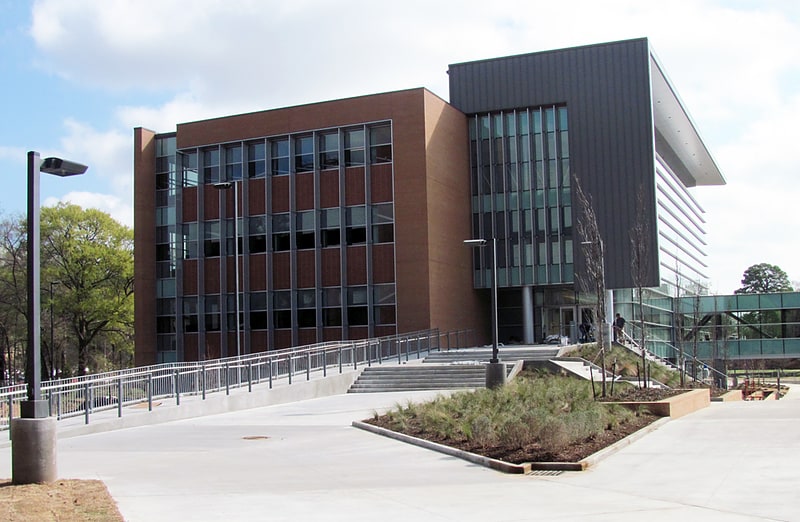
Public university in Little Rock, Arkansas. The University of Arkansas at Little Rock is a public research university in Little Rock, Arkansas. Established as Little Rock Junior College by the Little Rock School District in 1927, the institution became a private four-year university under the name Little Rock University in 1957. It returned to public status in 1969 when it merged with the University of Arkansas System under its present name. The former campus of Little Rock Junior College is now the campus of Philander Smith College.
Located on 250 acres (100 ha), the UA Little Rock campus encompasses more than 56 buildings, including the Center for Nanotechnology Integrative Sciences, the Emerging Analytics Center, the Sequoyah Research Center, and the Ottenheimer Library Additionally, UA Little Rock houses special learning facilities that include a learning resource center, art galleries, KUAR public radio station, University Television, and a campus-wide wireless network. It is classified among "R2: Doctoral Universities – High research activity".[29]
Address: 2801 S University Ave, 72204-1000 Little Rock
Boyle Park
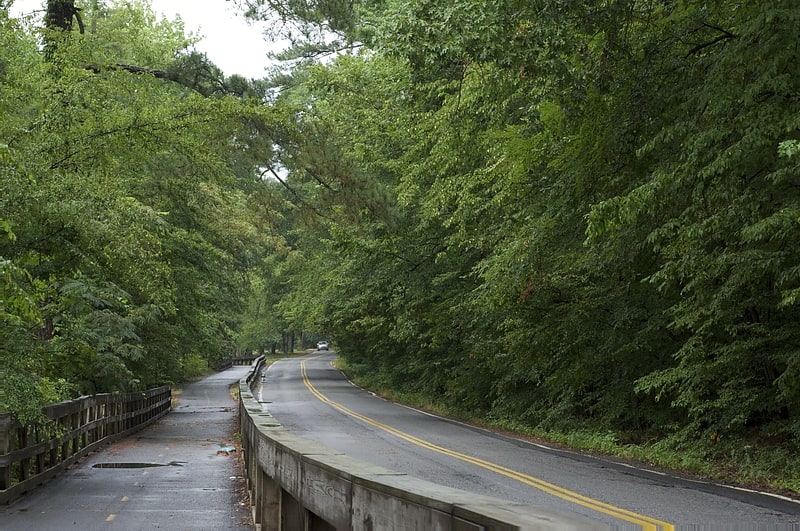
Park in Little Rock, Arkansas. Boyle Park is an approximately 250 acre urban park located in west-central Little Rock. The land for Boyle Park was donated to the City of Little Rock in 1929 by Dr. John F. Boyle. It was added to the National Register of Historic Places in 1995 for the eight known intact examples of Civilian Conservation Corps rustic architecture.
The park is mostly unimproved woodland. However, the park contains a small wildlife pond, two playgrounds, three pavilions, one gazebo, open meadows, woods, and numerous hiking and biking trails. Rock Creek flows through the park.[30]
First United Methodist Church
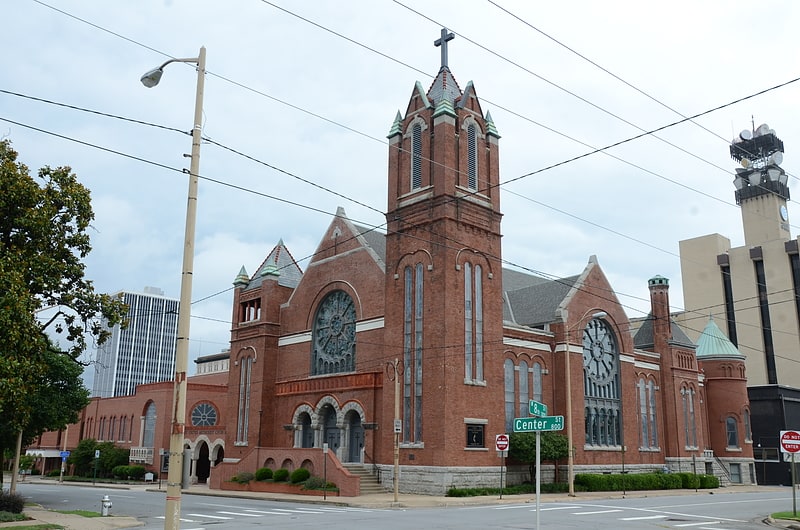
United methodist church in Little Rock, Arkansas. The First United Methodist Church is a historic church at 723 Center Street in Little Rock, Arkansas. It is a large brick building, designed by Frank W. Gibb and built in 1899–1900. It is one of the city's finest examples of Romanesque Revival architecture, with square towers at its corners, and its predominantly smooth brick exterior contrasted by rusticated granite trim. The congregation, founded in 1831, is the oldest Methodist congregation in the city, and the mother congregation of many of its other Methodist establishments. Its senior pastor is the Rev. David Freeman.
The building was listed on the National Register of Historic Places in 1986.[31]
Address: 723 Center St, 72201 Little Rock
Museum of Black Arkansans and Performing Arts Center

Museum in Little Rock, Arkansas. The Museum of Black Arkansans and Performing Arts Center is a museum and performing arts venue at 1224 South Louisiana Street in Little Rock, Arkansas. It is located on the former campus of the First Baptist Church of Little Rock, an historic property listed on the National Register of Historic Places in 1994. The former church, built in 1941, is a prominent local example of Collegiate Gothic architecture, designed by local architect A.N. McAninch. Little Rock's First Baptist congregation now meets at 62 Pleasant Valley Drive.[32]
Arkansas State Library
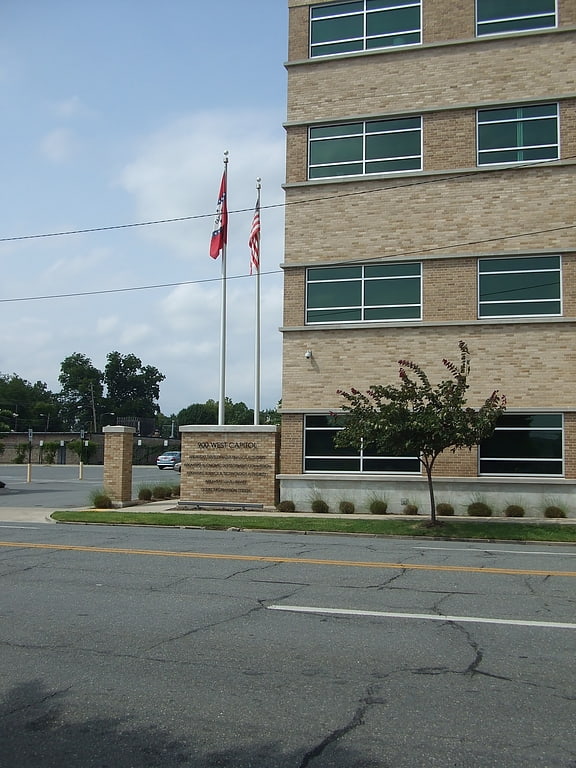
Public library in Little Rock, Arkansas. Arkansas State Library is a special library that operates as a state agency under the Arkansas Department of Education within Arkansas state government. It provides information resources for state agencies, legislators and legislative staffs. In addition, the Arkansas State Library provides guidance and support for the development of local public libraries and library services. Finally, the ASL provides resources, services, and leadership for the educational, informational and cultural needs of Arkansas citizens.[33]
Address: 900 W Capitol Ave, 72201 Little Rock
Mount Zion Baptist Church
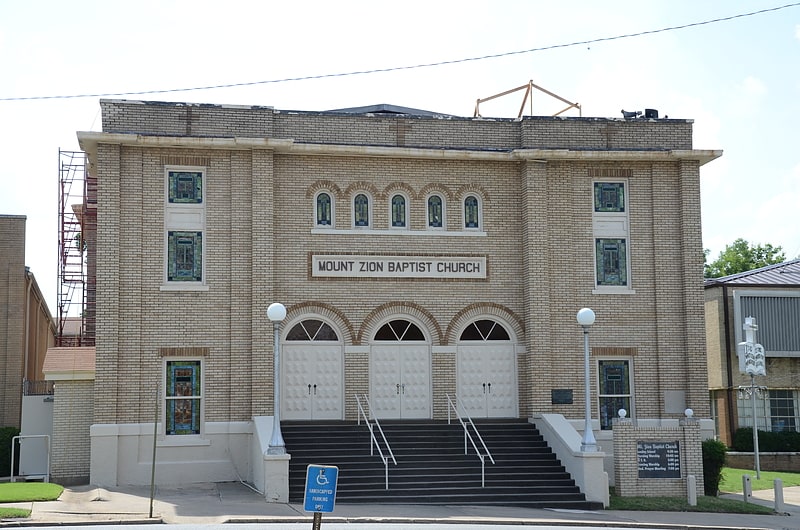
Church in Little Rock, Arkansas. Mount Zion Baptist Church is a historic church at 900 Cross Street in Little Rock, Arkansas. It is a buff brick structure with modest Prairie School features on its exterior, with a three-part facade articulated by brick pilasters, and a trio of entrances set in the center section above a raised basement. The interior of the church is extremely elaborate in its decoration, with a pressed-metal ceiling, elaborate central copper light fixture, and banks of stained glass windows. The church was built in 1926 for a predominantly African-American congregation founded in 1877.
The building was listed on the National Register of Historic Places in 1987.[34]
Address: 908 S Cross St, 72202-3627 Little Rock
Little Rock City Hall
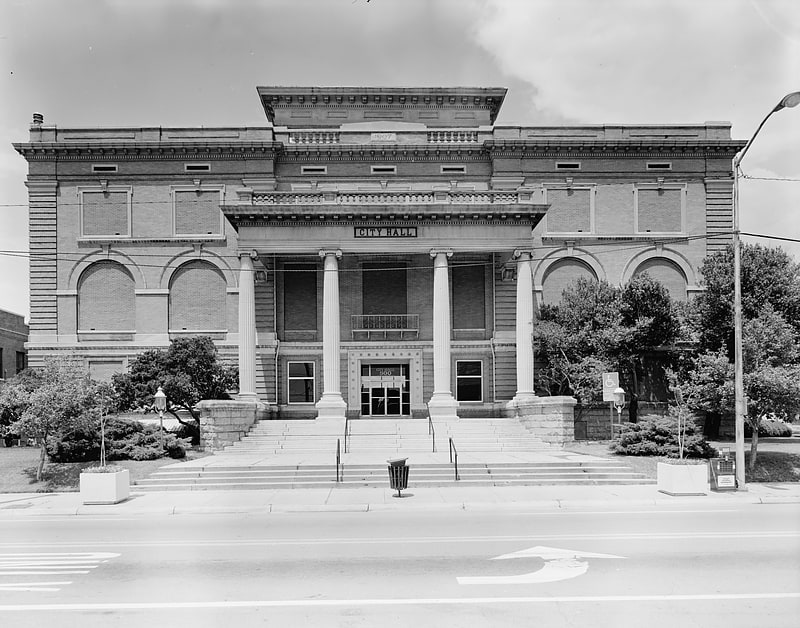
Building in Little Rock, Arkansas. Little Rock City Hall, the seat of municipal government of the city of Little Rock, Arkansas, is located at 500 West Markham Street, in the city's downtown. It is a Renaissance Revival structure, designed by Arkansas architect Charles L. Thompson and built in 1907. Its main facade has a projecting Roman portico, supported by fluted Ionic columns, with flanking sections that have Roman-style round-arch openings. The building housed most of the city's departments until the 1950s.
The building was listed on the National Register of Historic Places in 1979.[35]